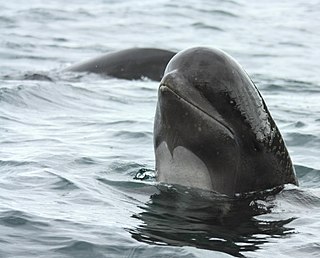Blackfish is a common name for various species of fishes and cetaceans, including:

The short-finned pilot whale is one of the two species of cetaceans in the genus Globicephala, which it shares with the long-finned pilot whale. It is part of the oceanic dolphin family (Delphinidae).

The long-finned pilot whale is a large species of oceanic dolphin. It shares the genus Globicephala with the short-finned pilot whale. Long-finned pilot whales are known as such because of their unusually long pectoral fins.

Pilot whales are cetaceans belonging to the genus Globicephala. The two extant species are the long-finned pilot whale and the short-finned pilot whale. The two are not readily distinguishable at sea, and analysis of the skulls is the best way to distinguish between the species. Between the two species, they range nearly worldwide, with long-finned pilot whales living in colder waters and short-finned pilot whales living in tropical and subtropical waters. Pilot whales are among the largest of the oceanic dolphins, exceeded in size only by the orca. They and other large members of the dolphin family are also known as blackfish.

The melon is a mass of adipose tissue found in the forehead of all toothed whales. It focuses and modulates the animal's vocalizations and acts as a sound lens. It is thus a key organ involved in communication and echolocation.

Cetotheriidae is a family of baleen whales. The family is known to have existed from the Late Oligocene to the Early Pleistocene before going extinct. Although some phylogenetic studies conducted by Fordyce & Marx 2013 recovered the living pygmy right whale as a member of Cetotheriidae, making the pygmy right whale the only living cetotheriid, other authors either dispute this placement or recover Neobalaenidae as a sister group to Cetotheriidae.

Orcinus citoniensis is an extinct species of killer whale identified in the Late Pliocene of Italy and the Early Pleistocene of England. It was smaller than the modern killer whale, 4 m (13 ft) versus 7 to 10 m, and had around 8 more teeth in its jaw. It may have resembled the modern killer whale in appearance, and could represent a transitional species between the modern killer whale and other dolphins. O. citoniensis could have hunted fish and squid in pods, and coexisted with other large predators of the time such as the orcinine Hemisyntrachelus and the extinct shark Otodus megalodon.

Idiocetus is a genus of extinct cetaceans of the family Balaenidae.

Dorete Bloch, married name Dorete Bloch Danielsen, was a Danish zoologist, former director of Náttúrugripasavnið, editor of Fróðskaparrit and author of numerous books on the animals and plants of the Faroe Islands. Bloch was born in Rungsted but moved to the Faroe Islands in 1974, where she remained for the rest of her life. She published studies on pilot whales, gaining a D.Phil in their study in 1991, covering aspects such as their migration patterns, diving behaviour and their importance on Faroese society.

Kogia pusilla is an extinct species of sperm whale from the Middle Pliocene of Italy related to the modern day dwarf sperm whale and pygmy sperm whale. It is known from a single skull discovered in 1877, and was considered a species of beaked whale until 1997. The skull shares many characteristics with other sperm whales, and is comparable in size to that of the dwarf sperm whale. Like the modern Kogia, it probably hunted squid in the twilight zone, and frequented continental slopes. The environment it inhabited was likely a calm, nearshore area with a combination sandy and hard-rock seafloor. K. pusilla likely died out due to the ice ages at the end of the Pliocene.

Balaenoptera siberi is an extinct species of baleen whale from the Late Miocene, described by Pilleri and Pilleri in 1989, based on fossils found in the Pisco Formation of the Pisco Basin in southwestern Peru.

Globicephalinae is a subfamily of oceanic dolphins that includes the pilot whales, the pygmy killer whale, the rough-toothed dolphin, the false killer whale, the melon-headed whale, Risso's dolphin, and the snubfin dolphins.
Mycteriacetus is an extinct genus of dolphin from the Early Miocene (Burdigalian) of northeastern Italy. The type species is M. bellunensis.










